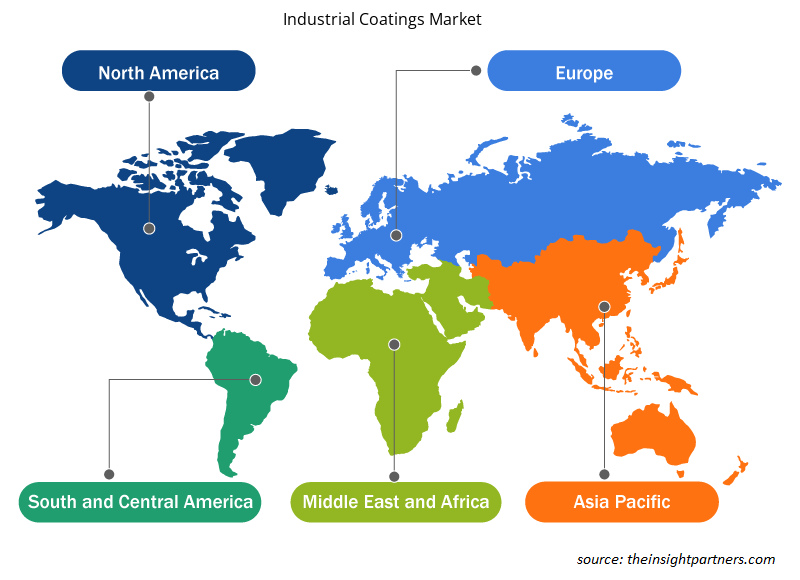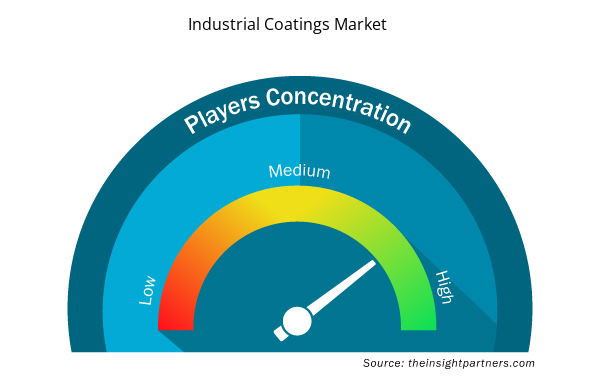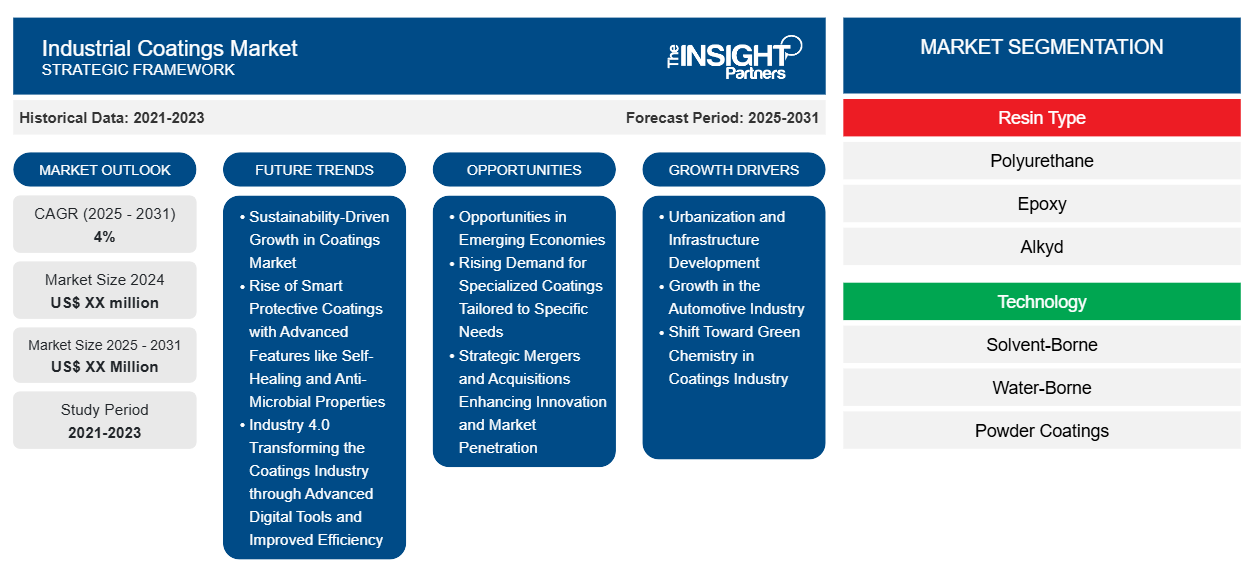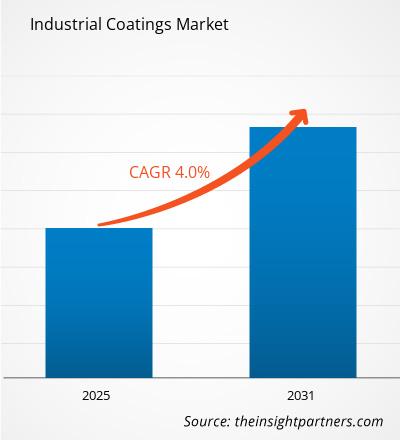工業用コーティング市場は、2023年から2031年にかけて4%のCAGRで成長し、市場規模は2023年のXX百万米ドルから2031年にはXX百万米ドルに拡大すると予想されています。
工業用コーティング市場レポートは、樹脂の種類(ポリウレタン、エポキシ、アルキド、アクリル、ポリエステル、フッ素ポリマーなど)別にセグメント化されています。市場は、技術(溶剤系、水性、粉体塗料)に基づいてセグメント化されています。市場は、最終用途産業(石油・ガス、自動車、海洋、風力タービン、産業機械、航空宇宙、包装など)に基づいてセグメント化されています。グローバル分析は、地域レベルと主要国でさらに細分化されています。すべての主要な市場セグメントの市場規模と予測は、グローバル、地域、国レベルでカバーされています。レポートでは、上記の分析、セグメント、地域、国について、USDでの値を提供しています。レポートでは、市場動向だけでなく、推進要因、制約、主要な機会などの市場動向も取り上げています。レポートでは、市場集中、ヒートマップ分析、主要プレーヤー、市場の最近の動向を含む業界の状況と競争分析も取り上げています。
報告書の目的
The Insight Partners のレポート「工業用コーティング市場」は、現在の状況と将来の成長、主な推進要因、課題、機会を説明することを目的としています。これにより、次のようなさまざまなビジネス関係者に洞察が提供されます。
- テクノロジープロバイダー/メーカー: 進化する市場の動向を理解し、潜在的な成長機会を把握することで、情報に基づいた戦略的意思決定が可能になります。
- 投資家: 市場の成長率、市場の財務予測、バリュー チェーン全体に存在する機会に関する包括的な傾向分析を実施します。
- 規制機関: 市場の濫用を最小限に抑え、投資家の信用と信頼を維持し、市場の完全性と安定性を維持することを目的として、市場における政策と警察活動を規制します。
工業用コーティング市場のセグメンテーション
樹脂タイプ
- ポリウレタン
- エポキシ
- アルキド
- アクリル
- ポリエステル
- フッ素ポリマー
テクノロジー
- 溶剤系
- 水系
- 粉体塗装
最終用途産業
- 石油とガス
- 自動車
- マリン
- 風力タービン
- 産業機械
- 航空宇宙
- パッケージ
地理
- 北米
- ヨーロッパ
- アジア太平洋
- 南米と中央アメリカ
- 中東およびアフリカ
地理
- 北米
- ヨーロッパ
- アジア太平洋
- 南米と中央アメリカ
- 中東およびアフリカ
要件に合わせてレポートをカスタマイズする
このレポートの一部、国レベルの分析、Excelデータパックなど、あらゆるレポートを無料でカスタマイズできます。また、スタートアップや大学向けのお得なオファーや割引もご利用いただけます。
- このレポートの主要な市場動向を入手してください。この無料サンプルには、市場動向から見積もりや予測に至るまでのデータ分析が含まれます。
工業用コーティング市場の成長要因
- 都市化とインフラ開発: 急速な都市化と、特に橋梁、高速道路、鉄道の建設といったインフラ開発に対する政府資金の増加により、耐久性の高い工業用塗料の需要が高まっています。このようなコーティングは、腐食や物理的損傷に対する保護として機能し、構造物の寿命を延ばします。
- 自動車産業の成長: 自動車産業の成長は、工業用コーティングの需要を促進する大きな要因となっています。軽量化と外観の向上を目指すトレンドの変化に伴い、生産者は、効率性と環境への配慮を高めた保護コーティングの適用を可能にする新しい技術を取り入れています。
- コーティング業界におけるグリーンケミストリーへの移行: 近年、コーティング業界は、厳しい規制と環境に優しい製品に対する消費者の嗜好の高まりにより、グリーンケミストリーに傾倒しています。この場合、ほとんどの企業が環境に害を与えることなく規制に準拠しようと努めているため、低 VOC (揮発性有機化合物) レベルと水性コーティングに重点が置かれています。
工業用コーティング市場の将来動向
- コーティング市場における持続可能性主導の成長: 持続可能性に向けた動きが市場を牽引すると予想されます。バイオベースの材料またはリサイクル材料から配合されたコーティングの革新の大幅な成長は、二酸化炭素排出量を削減したい環境意識の高い消費者や業界をターゲットにしたものと見られることが予想されます。
- 自己修復や抗菌特性などの高度な機能を備えたスマート保護コーティングの台頭: 自己修復、色の変化、抗菌特性などの機能を備えたスマート保護コーティングの生産が増加傾向にあります。このようなコーティングは、目的を達成するためにナノテクノロジーやその他の高度な材料を採用しており、医療や建設分野など、さまざまな用途で使用されているため、需要が高まっています。
- インダストリー 4.0 は、高度なデジタル ツールと効率性の向上によりコーティング業界を変革します。インダストリー 4.0 テクノロジの採用により、コーティング業界に変化がもたらされます。アプリケーションの監視と制御、予測メンテナンス、データ分析に高度なデジタル ツールを使用すると、効率性が向上し、無駄が減り、製品の品質が向上します。
工業用コーティング市場の機会
- 新興経済における機会: 新興経済における急速な工業化は、大きな成長の機会をもたらします。アジア太平洋、ラテンアメリカ、アフリカなどの地域では、インフラと製造業の成長により、工業用コーティングに対する需要が高まっています。
- 特定のニーズに合わせた特殊コーティングの需要の高まり: 防錆コーティング、耐熱コーティング、純粋に装飾的なコーティングなど、特定の用途向けに特別に設計されたコーティングの使用が増加しています。企業は、すでに設計されている製品に差別化機能を作成することで、市場の特定の部分を狙うこともできます。
- 戦略的合併と買収によるイノベーションと市場浸透の強化: 合併と買収を最適に活用することで、市場での存在感とテクノロジーを向上させることができます。テクノロジー企業やメーカーとの協力により、企業はより革新的になり、製品を強化し、新しい市場に参入することができます。
工業用コーティング市場の地域別分析
予測期間を通じて工業用コーティング市場に影響を与える地域的な傾向と要因は、Insight Partners のアナリストによって徹底的に説明されています。このセクションでは、北米、ヨーロッパ、アジア太平洋、中東、アフリカ、南米、中米にわたる工業用コーティング市場のセグメントと地理についても説明します。

- 工業用コーティング市場の地域別データを入手
工業用コーティング市場レポートの範囲
| レポート属性 | 詳細 |
|---|---|
| 2023年の市場規模 | XX百万米ドル |
| 2031年までの市場規模 | XX百万米ドル |
| 世界のCAGR(2023年~2031年) | 4% |
| 履歴データ | 2021-2022 |
| 予測期間 | 2024-2031 |
| 対象セグメント | 樹脂の種類別
|
| 対象地域と国 | 北米
|
| 市場リーダーと主要企業プロフィール |
|
工業用コーティング市場のプレーヤー密度:ビジネスダイナミクスへの影響を理解する
工業用コーティング市場は、消費者の嗜好の変化、技術の進歩、製品の利点に対する認識の高まりなどの要因により、エンドユーザーの需要が高まり、急速に成長しています。需要が高まるにつれて、企業は提供を拡大し、消費者のニーズを満たすために革新し、新たなトレンドを活用し、市場の成長をさらに促進しています。
市場プレーヤー密度とは、特定の市場または業界内で活動している企業または会社の分布を指します。これは、特定の市場スペースに、その市場規模または総市場価値に対してどれだけの競合相手 (市場プレーヤー) が存在するかを示します。
工業用コーティング市場で事業を展開している主要企業は次のとおりです。
- アクゾノーベルNV
- アジアンペイント
- アクサルタコーティングシステムズ LLC
- BASF SE
- ヘンペルA/S
免責事項:上記の企業は、特定の順序でランク付けされていません。

- 工業用コーティング市場のトップキープレーヤーの概要を入手
主なセールスポイント
- 包括的なカバレッジ: レポートでは、工業用コーティング市場の製品、サービス、タイプ、エンドユーザーの分析を包括的にカバーし、全体的な展望を提供します。
- 専門家による分析: レポートは、業界の専門家とアナリストの深い理解に基づいてまとめられています。
- 最新情報: このレポートは、最新の情報とデータの傾向を網羅しているため、ビジネスの関連性を保証します。
- カスタマイズ オプション: このレポートは、特定のクライアント要件に対応し、ビジネス戦略に適切に適合するようにカスタマイズできます。
したがって、工業用コーティング市場に関する調査レポートは、業界のシナリオと成長の見通しを解読し理解する道の先導役となることができます。正当な懸念事項がいくつかあるかもしれませんが、このレポートの全体的な利点は欠点を上回る傾向があります。
- 過去2年間の分析、基準年、CAGRによる予測(7年間)
- PEST分析とSWOT分析
- 市場規模価値/数量 - 世界、地域、国
- 業界と競争環境
- Excel データセット


- Machine Condition Monitoring Market
- Emergency Department Information System (EDIS) Market
- Customer Care BPO Market
- Equipment Rental Software Market
- Frozen Potato Market
- Fish Protein Hydrolysate Market
- Skin Graft Market
- Precast Concrete Market
- Fixed-Base Operator Market
- Analog-to-Digital Converter Market

Report Coverage
Revenue forecast, Company Analysis, Industry landscape, Growth factors, and Trends

Segment Covered
This text is related
to segments covered.

Regional Scope
North America, Europe, Asia Pacific, Middle East & Africa, South & Central America

Country Scope
This text is related
to country scope.
よくある質問
The development of sustainable coatings is expected to be the key market trends.
Based on geography, Asia Pacific held the largest share of the industrial coatings market due to its growing automotive, packaging, and wind turbine industry.
Based on end-use industry, the wind turbine segment is expected to witness the fastest growth during the forecast period.
The strong growth of the industrial sector across the globe is driving the market growth.
Hempel A/S, Nippon Paint Holdings, Jamestown Coating Technologies, The Sherwin-Williams Company, PPG Industries Inc., Kansai Paint Co.Ltd., ArcelorMittal, Mankiewicz Hamburg, Akzo Nobel N.V., and Baril Coatings USA are the key players operating in the industrial coatings market.
The Industrial Coatings Market is estimated to witness a CAGR of 4% from 2023 to 2031
Trends and growth analysis reports related to Chemicals and Materials : READ MORE..
The List of Companies
- Akzo Nobel N.V.
- Asian Paints
- Axalta Coating Systems, LLC
- BASF SE
- Hempel A/S
- Jotun
- Kansai Paint Co., Ltd.
- Nippon Paint Holdings Co., Ltd.
- PPG Industries, Inc.
- The Sherwin-Williams Company
The Insight Partners performs research in 4 major stages: Data Collection & Secondary Research, Primary Research, Data Analysis and Data Triangulation & Final Review.
- Data Collection and Secondary Research:
As a market research and consulting firm operating from a decade, we have published and advised several client across the globe. First step for any study will start with an assessment of currently available data and insights from existing reports. Further, historical and current market information is collected from Investor Presentations, Annual Reports, SEC Filings, etc., and other information related to company’s performance and market positioning are gathered from Paid Databases (Factiva, Hoovers, and Reuters) and various other publications available in public domain.
Several associations trade associates, technical forums, institutes, societies and organization are accessed to gain technical as well as market related insights through their publications such as research papers, blogs and press releases related to the studies are referred to get cues about the market. Further, white papers, journals, magazines, and other news articles published in last 3 years are scrutinized and analyzed to understand the current market trends.
- Primary Research:
The primarily interview analysis comprise of data obtained from industry participants interview and answers to survey questions gathered by in-house primary team.
For primary research, interviews are conducted with industry experts/CEOs/Marketing Managers/VPs/Subject Matter Experts from both demand and supply side to get a 360-degree view of the market. The primary team conducts several interviews based on the complexity of the markets to understand the various market trends and dynamics which makes research more credible and precise.
A typical research interview fulfils the following functions:
- Provides first-hand information on the market size, market trends, growth trends, competitive landscape, and outlook
- Validates and strengthens in-house secondary research findings
- Develops the analysis team’s expertise and market understanding
Primary research involves email interactions and telephone interviews for each market, category, segment, and sub-segment across geographies. The participants who typically take part in such a process include, but are not limited to:
- Industry participants: VPs, business development managers, market intelligence managers and national sales managers
- Outside experts: Valuation experts, research analysts and key opinion leaders specializing in the electronics and semiconductor industry.
Below is the breakup of our primary respondents by company, designation, and region:

Once we receive the confirmation from primary research sources or primary respondents, we finalize the base year market estimation and forecast the data as per the macroeconomic and microeconomic factors assessed during data collection.
- Data Analysis:
Once data is validated through both secondary as well as primary respondents, we finalize the market estimations by hypothesis formulation and factor analysis at regional and country level.
- Macro-Economic Factor Analysis:
We analyse macroeconomic indicators such the gross domestic product (GDP), increase in the demand for goods and services across industries, technological advancement, regional economic growth, governmental policies, the influence of COVID-19, PEST analysis, and other aspects. This analysis aids in setting benchmarks for various nations/regions and approximating market splits. Additionally, the general trend of the aforementioned components aid in determining the market's development possibilities.
- Country Level Data:
Various factors that are especially aligned to the country are taken into account to determine the market size for a certain area and country, including the presence of vendors, such as headquarters and offices, the country's GDP, demand patterns, and industry growth. To comprehend the market dynamics for the nation, a number of growth variables, inhibitors, application areas, and current market trends are researched. The aforementioned elements aid in determining the country's overall market's growth potential.
- Company Profile:
The “Table of Contents” is formulated by listing and analyzing more than 25 - 30 companies operating in the market ecosystem across geographies. However, we profile only 10 companies as a standard practice in our syndicate reports. These 10 companies comprise leading, emerging, and regional players. Nonetheless, our analysis is not restricted to the 10 listed companies, we also analyze other companies present in the market to develop a holistic view and understand the prevailing trends. The “Company Profiles” section in the report covers key facts, business description, products & services, financial information, SWOT analysis, and key developments. The financial information presented is extracted from the annual reports and official documents of the publicly listed companies. Upon collecting the information for the sections of respective companies, we verify them via various primary sources and then compile the data in respective company profiles. The company level information helps us in deriving the base number as well as in forecasting the market size.
- Developing Base Number:
Aggregation of sales statistics (2020-2022) and macro-economic factor, and other secondary and primary research insights are utilized to arrive at base number and related market shares for 2022. The data gaps are identified in this step and relevant market data is analyzed, collected from paid primary interviews or databases. On finalizing the base year market size, forecasts are developed on the basis of macro-economic, industry and market growth factors and company level analysis.
- Data Triangulation and Final Review:
The market findings and base year market size calculations are validated from supply as well as demand side. Demand side validations are based on macro-economic factor analysis and benchmarks for respective regions and countries. In case of supply side validations, revenues of major companies are estimated (in case not available) based on industry benchmark, approximate number of employees, product portfolio, and primary interviews revenues are gathered. Further revenue from target product/service segment is assessed to avoid overshooting of market statistics. In case of heavy deviations between supply and demand side values, all thes steps are repeated to achieve synchronization.
We follow an iterative model, wherein we share our research findings with Subject Matter Experts (SME’s) and Key Opinion Leaders (KOLs) until consensus view of the market is not formulated – this model negates any drastic deviation in the opinions of experts. Only validated and universally acceptable research findings are quoted in our reports.
We have important check points that we use to validate our research findings – which we call – data triangulation, where we validate the information, we generate from secondary sources with primary interviews and then we re-validate with our internal data bases and Subject matter experts. This comprehensive model enables us to deliver high quality, reliable data in shortest possible time.


 このレポートの無料サンプルを入手する
このレポートの無料サンプルを入手する